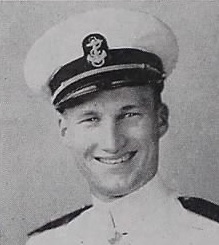
When you think of the Navy and basketball, does any particular state spring to mind? Is it Florida—Naval Air Station Pensacola and the Heat/Magic? Maybe California—Naval Base San Diego and the Lakers/Golden State? I’m willing to bet it’s not South Dakota, a land-locked state without an NBA team. Nevertheless, South Dakota produced two of the highest-scoring naval aviators of World War II, Cecil Harris and Joe Foss, and one of the country’s premier collegiate point guards, Harold Thune. Harold wasn’t just a warrior on the courts, though: he also served alongside Cecil Harris as a fighter pilot in USS Intrepid’s VF-18 squadron.
Harold’s father, Nikolai Gjelsvik, left his native Norway for the United States in 1906. He changed his name to Nick Thune on arrival to help reinforce his American identity. Nick worked on the railroad in South Dakota and saved his earnings to open a hardware store. He made his American dream come true in a decade: by 1916 he was a property owner, business owner and married man. His wife gave birth to three sons. Harold Richard Thune was the second arrival, born December 28, 1919, in Mitchell, South Dakota.
When Harold was in the sixth grade, the family moved to Murdo, South Dakota. It was a basketball town through and through. There were school teams for kids in the fourth and fifth grade; there were makeshift baskets erected on virtually every garage and barn. Harold grew up immersed in the sport—and he excelled, too. In 1937, while in high school, he led the Murdo Coyotes to the state championships. Though they narrowly lost in the finals, Harold was the game’s leading scorer and was cited in local papers as the “outstanding player of the contest” after putting on a “sensational defensive performance.”
He was so good that a local doctor with some Big 10 connections took an interest in Harold and decided to help him break into the big leagues. Rather than attending college in his native South Dakota, the doctor proposed Harold enroll at Hibbing Junior College in neighboring Minnesota, where the University of Minnesota Golden Gophers talent scouts might notice him. Harold did just that, and before long he was not only noticed, but signed and put in the rotation as a point guard for Minnesota.
Harold proved himself as a sophomore during a game against his native South Dakota State Rabbits. After a rocky start to the second half, Minnesota’s coach opted to try out some of his new players. According to the Minneapolis Star Tribune, “Of the new men, Harold Thune…proved the most impressive, playing cool clever ball…” He continued his upward trajectory as a junior, helping lead the Golden Gophers to a Big 10 playoff berth that got them all the way to the semi-finals, where they lost by two points to the team that won the whole tournament: The University of Wisconsin Badgers. “Hal,” as he was known in the local press, was chosen as the season MVP for the Gophers and finished out his tenure there as co-captain of the team in 1942.
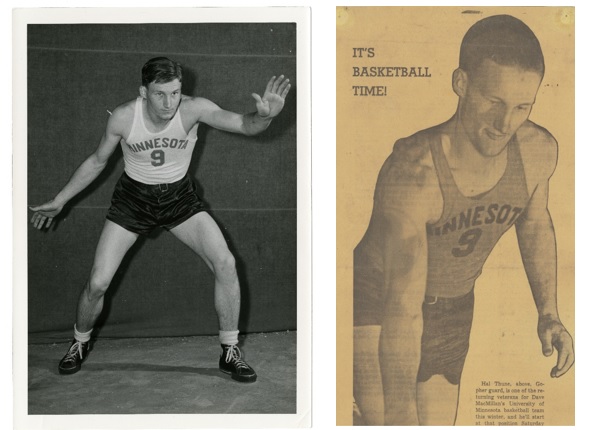
By that time, war had already come to American shores. Harold’s older brother Gilbert was a cook aboard USS Boggs, a destroyer-minesweeper in Hawaii, when Japanese planes came roaring over Pearl Harbor on December 7, 1941. His ship sped back to guard the approaches to the base against further attack, but by that point the damage was done. When Harold saw the headlines in the newspapers he knew what would come next. He quickly enlisted in the Navy, but because he was going into his senior year of college he was allowed to finish school before shipping out to training.
After graduation, Harold entered the aviation cadet program and was sent to Wold-Chamberlain Field in Minneapolis to begin flight training. Choosing naval aviation was a no-brainer for Harold. He’d grown up reading Boys’ Life, a publication of the Boy Scouts of America whose covers regularly featured aircraft like the lighter-than-air USS Akron and lumbering Boeing Clippers. Unlike the pages of his magazines, seeing planes in the sky was a rarity. When one did fly overhead, it could draw a crowd of excited onlookers—not just kids like Harold but adults, too.
The other novelty for Harold was the sea. He grew up in the middle of the country, more than 1,000 miles from the nearest ocean. The idea of water as far as the eye could see was about as alien a notion as flying thousands of feet in the air. It’s no wonder that when the time came to serve his country, Harold wanted to be a carrier pilot. It was the fulfillment of a childhood dream.
Training bounced him all around the country. After Minneapolis, he went to Corpus Christi, TX, for intermediate training with increasingly advanced aircraft. In April 1943 he was commissioned as an Ensign and had his Navy ‘wings of gold’ affixed to his tunic. From there, he was sent to Melbourne, FL, for operational training with aircraft that were actually being flown by carrier pilots at war.
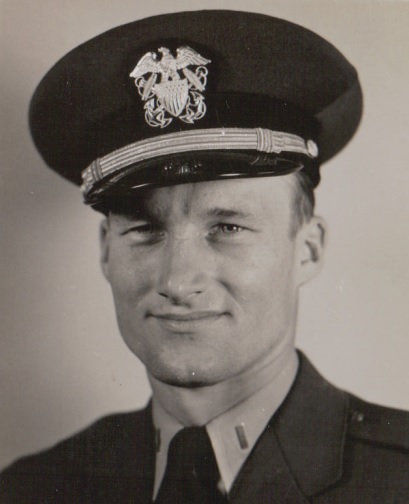
Harold had one last thing to accomplish before he was assigned to a squadron and sent into combat. While attending the University of Minnesota, he’d met a young woman who worked serving sodas on campus. The two hit it off and pursued a serious relationship, even as he was forced to move from state to state for training. In May 1943, while Harold was stationed in Florida, the two got engaged. They married the very next month. It was their last opportunity to do so before Harold’s training took him across the country, down to Hawaii, and thousands of miles across the Pacific.
On August 15, 1943, a new squadron, Fighting Squadron 36 (VF-36), was created as a standalone unit to be stationed on land. Harold Thune was assigned to the squadron and may have thought at that moment, ‘So much for my boyhood dream of aircraft carriers.’ But the squadron’s fortunes changed rapidly as ship after ship splashed out of dry dock and into the Navy’s waiting arms. Although none of the men in the squadron knew it at the time, just one day after VF-36 came into being, the USS Intrepid was commissioned. In a year’s time it would be their home.
Harold went with Fighting 36 to Naval Auxiliary Air Station Ream Field, outside of San Diego, for the last leg of training and carrier qualification. The make-or-break test after more than a year of hard work would be just a handful of touch-and-go landings on the short, stubby deck of the escort carrier USS Copahee. Harold and the rest of the young pilots went aboard on Saturday, November 20, 1943. Harold recalled the experience during an interview with his son in 2007:
“…[Y]ou had to make 4 landings before you were qualified to be accepted in the uh, into a squadron. And the ones that I made, when I flew what I thought was a good pattern and was ready to land, I got the wave off. Which is mandatory. You can’t land…And so I went around and when I was in what seemed to be about the most uncomfortable position I was in, then I would get a cut which meant, that’s also mandatory, you’ve got to take it.”
Though awkward at first, Harold passed carrier quals and later acclimated to the unique sensation of thudding down on a flattop. Three days later, he and the other men of VF-36 were put on a slightly bigger carrier, the light carrier USS Cabot, and sent down to Hawaii. For now it was goodbye wife, goodbye mom and dad, and goodbye to the life he had known for the better part of 24 years.
Training in Hawaii was intense. Attack and defense tactics, gunnery, and increasingly advanced maneuvers pushed both pilot and plane to their limit. VF-36 was also redesignated VF-18 at this time, since it was a squadron without an air group, and Air Group 18 needed a fighting squadron. The newly-completed carrier group practiced joining up in the air, flying out over a designated point and returning to base safely. Pilots spent upwards of six hours in the air on any given day. Harold’s flight log book recorded over 70 hours in the cockpit during the month of March 1944 alone, and over 700 hours of flying in total since 1942. Every hour in the air was becoming increasingly important. Any advantage he could eke out could spell the difference between life and death once the shooting started.

Fortunately for Harold, fellow South Dakotan Cecil Harris was put in charge of training the squadron. Harold said, “…he was a remarkable pilot, I’ve never seen anybody fly a plane like he did.” Harris’s unorthodox style lent itself well to the strengths and weakness of the F6F Hellcat, the plane Fighting 18 used in combat.
“…the tactics that were by the book, kind of, was…you come down and try to get on the tail of somebody and all the while they were losing speed. His was totally different. You come and you took ‘em head on. Then you broke away and then you’d come back up and uh, it was a totally different type of operation than we had gone through in training.”
“Cece” Harris also taught Harold,
“[I]f you had somebody on the tail, he said well, if you’d chop…your engine, horse back on the stick and stick it on its tail…then you’d kick over and you were on his tail. Well that happened…so I did try it and you’re moving at pretty good speed on that. So when you chop the engine off you slow down pretty quick. And then when you pull her up, actually you’re into a stall which is a dangerous thing…but he went by and I kicked back and…I was sitting on his tail.”
It was a dangerous but effective maneuver, a kind of mid-air switcheroo.
Harold was well-regarded by the leaders of his squadron. Everett Link, VF-18’s inaugural commanding officer, wrote in his fitness report, “Ensign Thune is a quick-witted determined person. He has unusual ability to plan and think for himself and do things without being told. He is exceptionally cool-headed and logical in his actions. His personality and character make him exceptionally successful in working with other officers to a common end. His ambition, sincerity, and ability make him an exceptionally good leader. He is strongly recommended for promotion.”
Edward Murphy, the man who ultimately commanded Fighting 18 aboard Intrepid, felt the same. Not only did he have glowing remarks to put in Harold’s fitness reports, Murphy assigned him as a section leader in his division, meaning he trusted Harold to watch his back in combat. Thune, who by July 1944 was promoted to Lieutenant (junior grade), was also made Assistant Flight Officer under “Cece” Harris. The two grew close enough that when it came time for Harris to get married in 1945, Harold stood up at his wedding.
During Harold’s time aboard Intrepid, he logged over 170 hours of flight time and more than two dozen strikes against enemy positions. The lessons he learned from Harris served him well. According to the Combat Accomplishments of Fighting Squadron 18 submitted by squadron skipper Ed Murphy, Harold is credited with:
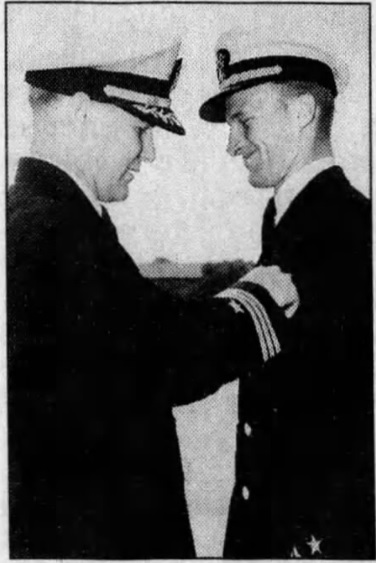
- 2 fighters shot down in air
- 1 fighter damaged in air
- 2 planes destroyed on ground
- 2 planes damaged on ground
- 2 hangars damaged by bombing runs
- 1 truck garage damaged
- 1 destroyer strafed
- 1 barge probably sunk (assist)
- 5 cargo ships damaged (strafe) (assist)
- Strafing and damaging a cruiser and destroyer during the Battle of Leyte Gulf
For the above deeds, Harold Thune was presented with the Air Medal (for Leyte Gulf) and the Distinguished Flying Cross (for his aerial victories).
In addition to being interviewed by his son for the Library of Congress’s Veterans History Project in 2007, Harold was interviewed by the Intrepid Museum’s Oral History Project ten years later, in 2017. It’s incredible what Harold could recall 60-70 years after these events took place. He remembers the intimate details: the kind of father/son bond formed between one of the squadron’s oldest pilots and one of its youngest; the time the squadron flight surgeon, Doc Fish, went to San Francisco to get some country records, and how they reminded guys of home when they spun on the scratchy phonograph aboard ship; how the Dutch freighter that took the squadron back to the U.S. had a huge shipment of fresh oranges that the pilots singlehandedly devoured—their first fresh fruit in God knew how long.
These interviews also reveal what carrier life was like for pilots between strike missions, when they had to occupy themselves physically and mentally to cope with the many stresses they were exposed to in wartime. Aside from playing cards and reading/writing letters, one of the favorite pastimes aboard Intrepid happened to be Harold’s forte: basketball.
“And so we had kids, college kids and stuff like that, pretty good athletes. And so we had, we put together a pretty good team. And on the hangar deck…they rigged up some baskets and we could play basketball down there. And of course the enlisted men also had a very good team. [Laughs] And uh, of course they loved to beat the officers. And I don’t know as they ever did quite beat us, but uh, there were some real—it was about the only time the enlisted men could gouge an officer and not get called for it. [Laughs] But we became pretty good friends with those guys.”
The squadron War History recalls this as well. “On quiet days there was usually sun, air and exercise on the flight deck. For the Air Group, it was mostly sun and air. The only thing that could pass for organized sport was basketball, played on the forward elevator. Pop Thune and his five usually trimmed the highly touted ships-company team…”
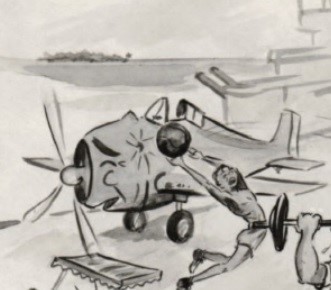
A kamikaze attack on November 25, 1944, took Intrepid temporarily out of action and caused the squadron to return home in early 1945. Harold was airborne when the attack occurred and forced to land with the rest of his flight on a small airstrip on Leyte, in the central Philippines. The next morning Harold and company gassed up, geared up and flew to Peleliu, where they’d again have to sleep and prepare for a final flight to Ulithi, the fleet anchorage where they could catch a ride home.
Harold’s closest brush with death occurred that morning at Peleliu.
“…I blew a tire on takeoff and blew up a plane. (laughs) And some of the guys wanted to come back and the skipper said, he didn’t have a chance…it isn’t even like having four wheels, you had two wheels. (laughs) One is down—you’re going where it’s going, is what it amounted to. But Peleliu had lots of coral, and when they built the runways, they pushed it off to the side, and big rocks and everything…so when I went off the runway, my bellytank hit one of those rocks and—it was in flames, immediately. And so, when I got stopped, I got out very quickly. (laughs) And of course they couldn’t see because the plane was all on fire and everything else. And so, they were certain that I was gone…And so, I stayed there. They took me to the infirmary and bandaged me up, and all that sort of stuff…”
Harold was healthy enough to catch a flight out to Ulithi shortly thereafter. Skipper Ed Murphy, meanwhile, was in his tent still reeling from the presumed loss of one of his pilots to such a senseless accident. Harold remembers that Murphy was “slightly surprised” when he walked into his tent alive and well. The whole squadron was no doubt overjoyed to see him. They had lost about a dozen men over the course of their deployment. They were tired of grieving. It was time to go home.
After the war, Harold left the Navy to help his father with the family’s hardware store. His wife, Pat, who had worked during the war in a factory inspecting gun sights, worked at the store as well. The couple ran it for 15 years. Both Harold and Pat later worked in the Murdo school system: Harold as a teacher—and basketball coach—and Pat as school librarian. The couple had five children including Senator John Thune, currently the second-ranking Republican in the United States Senate.
Harold Thune turned 100 years old in 2019 and is one of the only—if not the only—surviving member of Fighting Squadron 18.
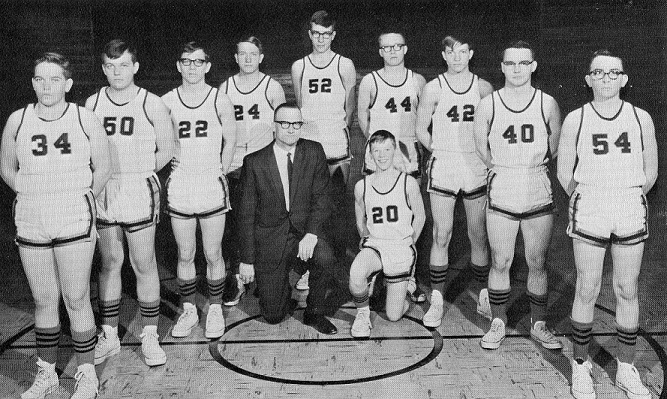

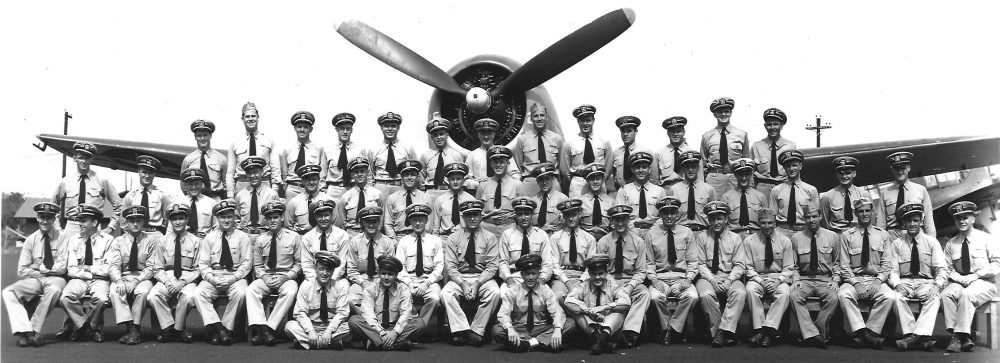
Pingback: Two-a-Day Tales: Brothers in Arms | Two-a-Day 18